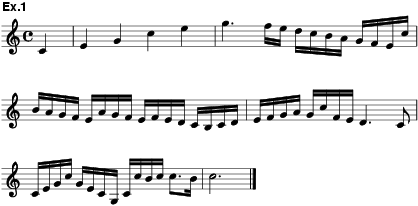
A term applied to various kinds of short preludial (occasionally postludial) pieces, originally improvised but later often written out.
In stage music the term usually refers to a call of the fanfare type, generally for trumpets with or without drums but sometimes for other instruments. Elizabethan dramatists frequently used the word in stage directions in this sense (e.g. Shakespeare, Antony and Cleopatra, Act 2 scene vii, ‘Sound a Flourish with drummes’). The flourish and the sennet were not identical, as a direction in Thomas Dekker's Satiromastix (1601) shows: ‘Trumpets sound a florish and then a Sennate’.
In a more specialized sense the term was used in England from the Restoration period to the 18th century to denote a short improvised prelude consisting largely of scales and arpeggios decorating a common chord. Its function was to acquaint the audience with the key of the following piece and, as in the toccata and other preludial forms, to allow the performer to test the tuning and functioning of his instrument and briefly to exercise his fingers in a passage of increasing brilliance in preparation for the performance. Roger North described a flourish as ‘sounding the proper accord-notes of an assumed key successively, and then breaking or mixing those notes as may best be done, dividendo, consonando, or arpeggiando, with what elegance and variation the fancy suggests or capacity admitts’. He went on to say that before a piece of ensemble music ‘the like may be performed in severall manners by any number of instruments, with perpetuall variety of fancy in each, and no one much regard what another doth; and in all that disorder upon the key the sound will be rich and amazing’.
Although the best performers improvised flourishes, many were printed for the less adept. Select Lessons for the Violin (London, 1702) contains A Florish or Prelude in Every Key designed to preface pieces in keys from C to F minor on the flat side and to A on the sharp side. The Florish in C fa ut Natural arpeggiates the common chord and then makes division on it in precisely the manner described by North (ex.1). That flourishes for several instruments were used for dramatic effect is apparent from Act 2 of Purcell's Dioclesian (1690), where the unaccompanied chorus ‘Sound all your instruments’ is followed by the direction ‘Flourish with all the instruments in C fa ut-Key’. Whether this practice was generally much employed in ensemble music outside the theatre is very doubtful.

With only a little elaboration the flourish becomes a prelude with formed thematic elements developed in rudimentary fashion. Some of the pieces in Select Preludes or Volentarys for the Violin (London, 1704), described on the title-page as ‘Florishes’, fall into this category. That by Purcell (Purcell Society Edition, xxxi, 93) is highly chromatic at the outset, so its main function as a true flourish, to impress the tonic chord on the listener, is no longer so evident.
Military flourishes were decorative trumpet calls or fanfares, more elaborate than the ‘duty’ and ‘routine calls’ and unlike them in not necessarily having any stereotyped features or promptly recognizable melodic outlines. Until the 18th century, British Army flourishes were ‘without any set rule’; later a fixed notation developed for those intended as salutes for royalty and general officers (see Signal).
In the prefatory note to the ‘Table of Graces proper to the Viol or Violin’ in his Introduction to the Skill of Musick (1660), John Playford used the word as synonymous with ‘graces’ or ornaments, at any rate with the more elaborate shaken graces. Eventually it came to be applied to almost any florid instrumental passage.
The Rudiments of War (London, 1777)
J.S. Manifold: The Music in English Drama from Shakespeare to Purcell (London, 1956)
J. Wilson, ed.: Roger North on Music (London, 1959), 142ff
P. Downey: The Trumpet and its Role in Music of the Renaissance and Early Baroque (diss., Queen's U., Belfast, 1983)
G. Strahle: An Early Music Dictionary; Musical Terms from British Sources 1500–1740 (Cambridge, 1995)
MICHAEL TILMOUTH